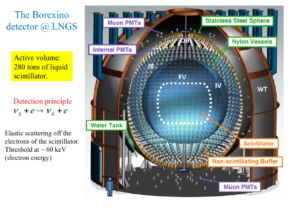Borexino: a real-time detector for low-energy neutrinos
Borexino is a particle physics experiment which has been performed by an international collaboration in the “Hall C” of the Laboratori Nazionali del Gran Sasso (LNGS). Its physics program was centered on solar neutrinos, but also included other relevant topics in low background neutrino detection (including geoneutrinos) and underground physics.
The name “Borexino” derives from that of a former proposal for a (rather different) solar neutrino experiment to be performed at LNGS, called “BOREX” (BORon solar neutrino EXperiment). Borex was never realized: it has been superseded by the (relatively) smaller but more advanced and ambitious Borexino detector.

The Borexino detector was a large, low background, liquid scintillator detector designed to reveal low energy (sub-MeV) neutrinos in real time. It was built with the main goals of performing solar neutrinos spectroscopy and to measure the 7Be neutrino flux from the Sun.
Extreme radio-purity
Achieving such goals required a very low energy threshold, which in turn required an extreme radiopurity: radioactive background in the Borexino detector had to be at least 10 orders of magnitude lower than in typical natural conditions!
Nothing in Borexino was standard
To achieve the required radiopurity levels, all detector parts and components had to be developed ad hoc. All involved materials had to be carefully selected for radiopurity (measurements on materials has been performed using germanium detectors and mass spectrometers), and everything had to go through clean rooms (five clean rooms has been built around the detector). The inside of the detector itself was equipped as a clean room. All welds were TIG in nitrogen or argon atmosphere. All surfaces were pickled and passivated. The nitrogen for stripping was cryogenically purified, etc. (check relevant papers for more details).
The Counting Test Facility
A Borexino prototype, called the Counting Test Facility (CTF), has been built and operated in the Hall C of LNGS between 1994 and ’96. This (now dismantled) detector demonstrated the achievement of ultra-low count rates (radiopurity of the order of 10-16g/g of 238U equivalent) on the several-ton scale.
The Borexino detector has been built on the CTF experience.
Timeline
- Official detailed proposal: August 1991
- Proof of concept (CTF prototype): 1994 – 1996
- Detector structures construction completed in 2004
- Detector filling completed on May 15, 2007
- First DAQ run started on May 16, 2007
- Last DAQ run (#36744) stopped on Oct 7, 2021
Results
The extraordinary radiopurity achieved by Borexino (unprecedented for such a large detector), further improved over the years, have made it possible to accomplish not only its primary goals but also to produce many other interesting results, both within and beyond the Standard Model of particle physics.
Open Data
A selection of the experimental data acquired and analysed by the Borexino collaboration for some of the most significant publications is freely available as “Open Data”.
For more information and details please refer to these articles:
- Technological Novelties and Scientific Discoveries with Borexino
- The Borexino detector at the Laboratori Nazionali del Gran Sasso
(detailed tech. description. Does not include latest improvements) - Technologies of the Borexino experiment: Introduction
- Science and Technology in very low energy neutrinos physics with Borexino
- Why and how the Sun and the stars shine
(general description, scientific and historical notes)
See also:
- Borexino General Meeting on Dec 2021 – Special Open Session
(recollection of history and achievements) - Borexino page on the LNGS web site
- How the Sun and the Stars shine